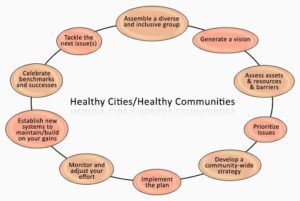Community health promotion is a vital aspect of public health that aims to improve the overall well-being of a community. The primary objectives of community health promotion efforts are to enhance the quality of life, prevent diseases, and promote healthier lifestyles. However, not all goals are equally prioritized in these efforts. In this article, we will explore the primary objectives of typical community health promotion initiatives and identify which goal may not always be a central focus.
Understanding Community Health Promotion

Community health promotion is a multidisciplinary approach that involves various stakeholders, including healthcare professionals, community leaders, and government agencies. These efforts aim to address health disparities, promote healthy behaviors, and empower communities to take control of their health.
Primary Goals of Community Health Promotion
- Disease Prevention and ControlOne of the foremost goals of community health promotion is to prevent the spread of diseases within the community. Efforts are directed towards reducing the incidence of communicable diseases like influenza, HIV/AIDS, and tuberculosis.
- Health Education and AwarenessPromoting health education and awareness is a crucial aspect of community health promotion. This includes disseminating information about nutrition, exercise, and the benefits of vaccinations to empower individuals to make informed decisions about their health.
- Behavioral ChangeEncouraging positive behavior change is another significant focus. Community health promotion efforts aim to reduce unhealthy habits such as smoking and excessive alcohol consumption, while encouraging physical activity and healthy eating.
- Access to Healthcare ServicesEnsuring access to quality healthcare services, including preventive care, is fundamental. This goal involves creating avenues for individuals to seek medical attention and access to affordable healthcare resources.
- Social and Environmental DeterminantsRecognizing that social and environmental factors play a significant role in health, community health promotion efforts strive to address these determinants. This includes reducing exposure to environmental toxins and advocating for social justice.
- Community EngagementEngaging the community is key to the success of health promotion efforts. Empowering individuals to take an active role in their health and participate in decision-making processes contributes to a healthier community.
Identifying the Non-Central Goal

While the aforementioned goals are the primary focus of community health promotion, it is important to note that not all objectives are equally emphasized. The goal that may not always receive the same level of attention is:
Mental Health Promotion
Mental health promotion is a critical aspect of overall well-being, yet it may not be as central a focus in typical community health promotion efforts. Often, these initiatives prioritize physical health, disease prevention, and behavioral change over mental health promotion. While many programs incorporate mental health components, they may not be as comprehensive or robust as other aspects of community health promotion.
It is essential to recognize that the neglect of mental health promotion can have significant implications for the overall health of a community. Mental health issues, such as depression and anxiety, can contribute to chronic diseases and reduced quality of life. Therefore, incorporating mental health promotion into community health efforts should be a more central goal.
Community health promotion primarily aims to prevent diseases, educate communities, promote healthy behaviors, improve access to healthcare, address social and environmental determinants, and engage the community. While these goals are pivotal, mental health promotion may not always receive the same level of attention, despite its critical role in the overall well-being of a community. A comprehensive approach to community health promotion should encompass mental health promotion as a central focus to achieve the best possible health outcomes for the community.


